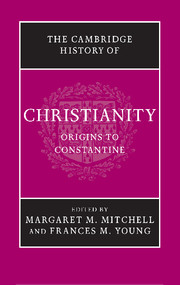Book contents
- Frontmatter
- Prelude: Jesus Christ, foundation of Christianity
- Part I The Political, Social and Religious Setting
- Part II The Jesus Movements
- Part III Community Traditions and Self-Definition
- Part IV Regional Varieties of Christianity in the First Three Centuries
- 15 From Jerusalem to the ends of the earth
- 16 Overview: the geographical spread of Christianity
- 17 Asia Minor and Achaea
- 18 Egypt
- 19 Syria and Mesopotamia
- 20 Gaul
- 21 North Africa
- 22 Rome
- Part V The Shaping of Christian Theology
- Part VI ‘Aliens’ become Citizens: towards Imperial Patronage
- Conclusion: retrospect and prospect
- Bibliographies
- Index
- Map 1. The Roman Empire in the time of Marcus Aurelius
- References
17 - Asia Minor and Achaea
from Part IV - Regional Varieties of Christianity in the First Three Centuries
Published online by Cambridge University Press: 28 March 2008
- Frontmatter
- Prelude: Jesus Christ, foundation of Christianity
- Part I The Political, Social and Religious Setting
- Part II The Jesus Movements
- Part III Community Traditions and Self-Definition
- Part IV Regional Varieties of Christianity in the First Three Centuries
- 15 From Jerusalem to the ends of the earth
- 16 Overview: the geographical spread of Christianity
- 17 Asia Minor and Achaea
- 18 Egypt
- 19 Syria and Mesopotamia
- 20 Gaul
- 21 North Africa
- 22 Rome
- Part V The Shaping of Christian Theology
- Part VI ‘Aliens’ become Citizens: towards Imperial Patronage
- Conclusion: retrospect and prospect
- Bibliographies
- Index
- Map 1. The Roman Empire in the time of Marcus Aurelius
- References
Summary
Asia Minor and Achaea were nurseries for Christianity, as the New Testament shows. The churches there were planted, grew and changed in environs which harboured a long history, within cities (Athens and Corinth, Ephesus and Pergumum among them) in which civic pride flourished and a diversity of cultures proliferated. The context for Christians’ lives was the empire and, for most of them, a polis with its rivalries, regional grandees, associations and gathered poor.
The evidence
Asia Minor is particularly important for understanding the development and diversification of the Christians’ religion. Its significant epigraphy includes overtly Christian inscriptions which pre-date Constantine, though the Christianity they represent (catholic, Montanist/New Prophet, Novatianist, and others) is often difficult to determine. Inscriptions help to compensate for gaps in terms of Christian writings, art and artefacts. Although some may be from the late second century, there is a dearth of them through the third in areas where Christians were (e.g. Asia’s western coastal region and Bithynia; cf. Plin. Ep. 10.96; Luc. Alex. 25). Of significance are (1) the openly Christian third-century epitaphs showing ‘Christians’ well integrated with their pagan neighbours; (2) the pre-216 ce epitaph of the Phrygian Abercius (Greek: Aberkios) (possibly Avircius Marcellus of Euseb. HE 5.16.3), telling of a common understanding of faith, hospitality and eucharist from Rome to Nisibis (cf. Iren. Haer. 1.10.2); and (3) the early third-century Greek and Latin inscription which seems finally to have located Tymion and the site of the New Prophets’/Montanists’ Phrygian ‘Jerusalem’.
Keywords
- Type
- Chapter
- Information
- The Cambridge History of Christianity , pp. 314 - 329Publisher: Cambridge University PressPrint publication year: 2006
References
- 4
- Cited by



